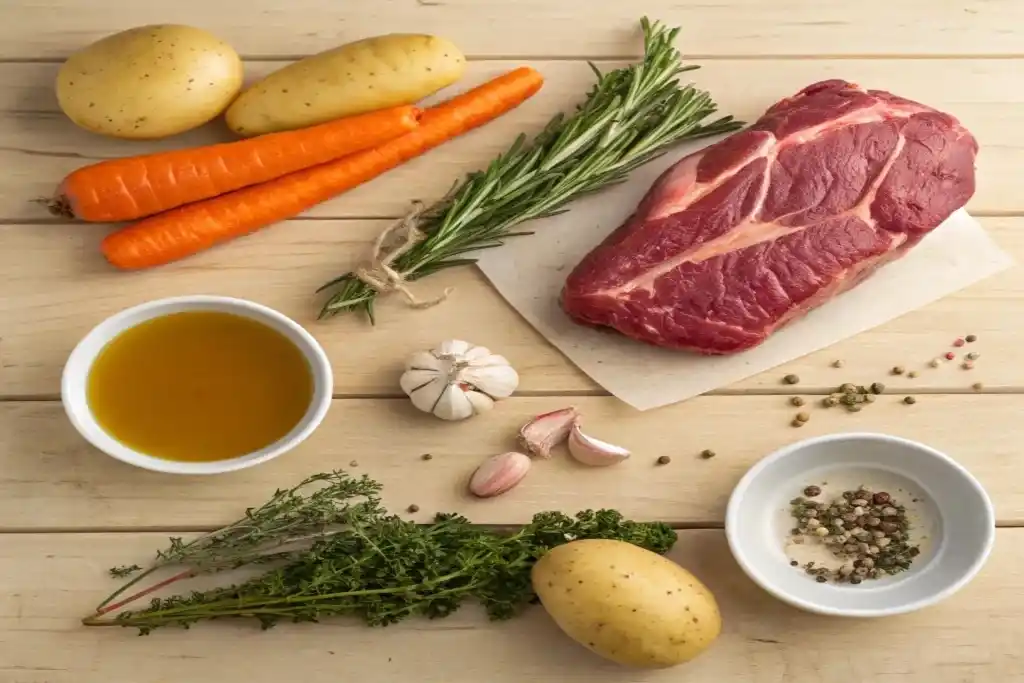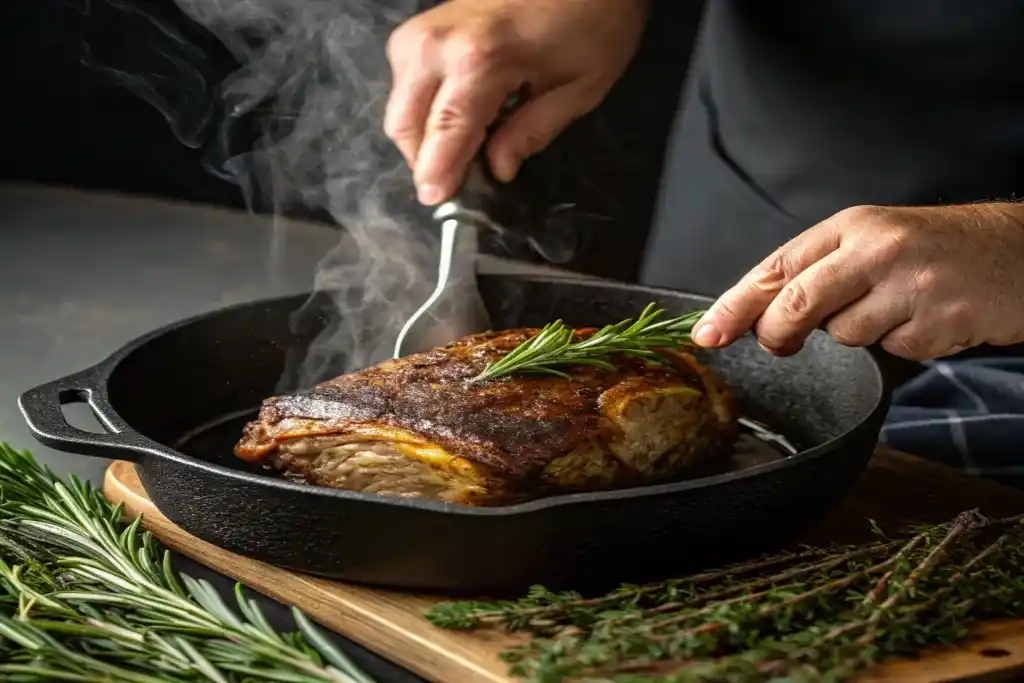Introduction
The Allure of a Perfect Beef Arm Roast
This beef arm roast recipe is your go-to guide for creating a hearty, flavorful meal that’s tender and satisfying. Known for its rich, beefy taste, the beef arm roast shines when cooked low and slow. As a result, it is perfect for cozy family dinners or meal prep. Whether you’re new to cooking roasts or, on the other hand, a seasoned home chef, this recipe ensures success every time.
Why This Cut Deserves a Spot at Your Dinner Table
Often overshadowed by other cuts like chuck roast, the arm roast is a leaner, budget-friendly option that delivers incredible flavor when prepared properly. If you’re curious about additional ideas, this guide to beef recipes offers versatile ways to cook and enhance dishes using this cut.
Essential Ingredients for a Tender Beef Arm Roast Recipe
Learn what makes this beef arm roast recipe foolproof with the right cut, seasonings, and vegetables for the perfect roast.
Selecting the Right Cut: Understanding Beef Arm Roast
When shopping for a beef arm roast, look for a cut that is roughly 3–4 pounds with good muscle structure and a slight amount of marbling. This leaner cut, sourced from the shoulder, is ideal for slow cooking, which breaks down its connective tissue and delivers tender, flavorful results. For other amazing ideas, discover delicious comfort foods that highlight the use of hearty ingredients like beef.
Marinades and Seasonings: Infusing Flavor
The key to a mouthwatering arm roast lies in the marinade. For a classic roast, combine olive oil, minced garlic, rosemary, thyme, and a splash of red wine vinegar or Worcestershire sauce. For those looking to mix it up, a smoky BBQ rub or a soy-based marinade with ginger and honey can elevate the flavor profile. Don’t forget to salt the roast generously at least an hour before cooking—this helps tenderize the meat and locks in moisture. Learn more tips for creating savory, bold meals in our expert collection.
Complementary Vegetables and Herbs
A great roast isn’t complete without hearty vegetables and fresh herbs. Common pairings include carrots, potatoes, onions, and celery, which cook beautifully alongside the roast, soaking up the juices. For a seasonal twist, consider adding parsnips, turnips, or pearl onions. Fresh rosemary and thyme sprigs placed on top of the roast while it cooks add an aromatic layer that ties the dish together.

Step-by-Step Instructions for Cooking Beef Arm Roast
Master this beef arm roast recipe with detailed steps for preparation, searing, and slow cooking to achieve tender, flavorful results.
Preparation: Setting the Stage for Success
Start by bringing your beef arm roast to room temperature—this ensures even cooking. Pat the roast dry with paper towels to help it brown properly. Generously season all sides with salt, pepper, and your preferred spice blend or marinade. If time allows, marinate the roast overnight in the fridge for maximum flavor infusion. Preheat your oven to 325°F (or set up your slow cooker or pressure cooker based on your cooking method).
Searing: Building Depth of Flavor
Heat 2 tablespoons of olive oil in a large skillet or Dutch oven over medium-high heat. Once the oil shimmers, sear the roast on all sides until a golden-brown crust forms—this step locks in juices and adds a robust flavor base. Remove the roast and set it aside.
Slow Cooking Techniques: Oven, Slow Cooker, and Pressure Cooker Methods
Oven Method:
Transfer the seared roast to a roasting pan or Dutch oven. Surround it with your chosen vegetables—carrots, potatoes, and onions—and pour in 2 cups of beef broth or red wine for moisture. Cover tightly with a lid or aluminum foil and roast in the oven for 3–4 hours, checking occasionally to ensure it doesn’t dry out.
Slow Cooker Method:
Place the roast in the slow cooker with vegetables and 2 cups of broth, red wine, or a mix of both. Set the slow cooker to low and cook for 8–10 hours, or on high for 4–6 hours. The result will be tender, fall-apart beef.
Pressure Cooker (Instant Pot) Method:
Using the sauté function, sear the roast directly in the Instant Pot, then deglaze the pot with broth or wine, scraping up any browned bits. Add vegetables and cook on high pressure for 60–75 minutes. Allow the pressure to release naturally for 15 minutes before venting.

Resting and Carving: Serving the Perfect Slice
Once cooked, let the roast rest for at least 15 minutes under foil to allow the juices to redistribute. When carving, slice against the grain to ensure tender bites. Serve with the roasted vegetables and drizzle the flavorful pan juices or gravy over the top.
Tips to Customize Your Beef Arm Roast Recipe
Explore variations in this beef arm roast recipe, including global flavors, dietary adjustments, and serving suggestions for every occasion.
Flavor Variations: Exploring Different Cuisines
One of the best aspects of cooking a beef arm roast is its adaptability to various cuisines. For a Mediterranean twist, use a marinade of olive oil, lemon juice, oregano, and garlic, and pair the roast with roasted tomatoes and olives. Prefer something smoky? Coat the roast with a BBQ dry rub made from smoked paprika, brown sugar, chili powder, and garlic powder. For a spicy kick, try a Mexican-inspired seasoning with cumin, chipotle powder, and lime juice, serving the roast with rice or tortillas.
Adjusting for Dietary Preferences and Restrictions
To make your roast keto-friendly, skip the starchy vegetables like potatoes and carrots and opt for low-carb options like cauliflower, zucchini, or green beans. For a gluten-free version, ensure all your marinades, broths, and sauces are certified gluten-free. If you’re preparing the dish for someone watching their sodium intake, use reduced-sodium broth and adjust salt levels accordingly.
Serving Suggestions: Pairing with Sides and Beverages
Elevate your beef arm roast with the perfect sides. Traditional pairings include creamy mashed potatoes, roasted Brussels sprouts, or a fresh green salad with vinaigrette. If you want to complement the roast’s richness, try tangy sides like pickled vegetables or a cranberry chutney. For beverages, a full-bodied red wine like Cabernet Sauvignon or a dark ale works wonders with the deep flavors of the roast.
Frequently Asked Questions About Beef Arm Roast Recipes
What is beef arm roast best for?
Beef arm roast is perfect for slow cooking and hearty meals. It’s a flavorful, budget-friendly cut that’s great for pot roasts. First, it gets super tender when cooked slowly, making it ideal for comfort foods. Next, it pairs well with vegetables like carrots and potatoes for a complete meal. You can also shred it for tacos, sandwiches, or stews. The beefy flavor shines in soups when cooked with broth. Plus, leftovers are always a win! Whether you’re meal-prepping or hosting a family dinner, beef arm roast delivers every time. It’s versatile and delicious—what’s not to love?
What is the best way to cook arm steak?
The best way to cook arm steak is low and slow. This cut loves tenderizing methods like braising or slow cooking. First, season it generously with salt, pepper, and your favorite spices. Next, sear it in a hot pan to lock in the juices. Then, cook it with broth in a slow cooker or Dutch oven for hours. This makes the meat soft and full of flavor. You can also try marinating it overnight for extra tenderness. Serve it with mashed potatoes or rice for a filling meal. Arm steak is comfort food at its best!
Can you overcook arm roast?
Yes, you can overcook arm roast, but it’s pretty forgiving if cooked slowly. Overcooking happens when you use high heat or leave it too long. First, keep the temperature low to prevent the meat from drying out. Next, always check for doneness after a few hours. When it’s tender and easy to pull apart, it’s done! Cooking it too long can make it mushy instead of juicy. Using a meat thermometer helps you avoid mistakes. Aim for tender, not overdone. Take it off heat in time, and your arm roast will stay delicious and perfect!
What temperature should roast beef be cooked at?
Roast beef should be cooked at 325°F for slow, even cooking. This temperature helps the meat stay tender and juicy. First, preheat your oven and season the roast well. Next, place it in a roasting pan with broth or veggies for extra flavor. Cook until the internal temperature reaches 145°F for medium doneness. Use a meat thermometer to check for accuracy. For a well-done roast, cook to 160°F. Let the roast rest for 10-15 minutes before slicing. Resting locks in the juices and makes it easier to carve. Stick to 325°F, and you’ll have perfect results every time!
Conclusion
Bring It All Together: Your Guide to the Perfect Beef Arm Roast
Cooking the perfect beef arm roast is easier than you think. With the right prep and simple techniques, anyone can do it. First, choose a good cut. Look for a beef arm roast with a bit of marbling for extra flavor. Next, season it well. A little salt, pepper, and your favorite herbs go a long way.
When it’s time to cook, take it low and slow. Slow cookers or ovens are your best friends for tender results. Don’t forget to let it rest before slicing. This keeps the juices locked in and the meat tender.
Finally, make it a meal to remember with delicious sides. Mashed potatoes, roasted veggies, or even fresh bread are perfect options. Leftovers? They make amazing sandwiches or soups.
Try it yourself—you’ll feel like a pro in the kitchen. It’s a recipe worth sharing with friends and family!
